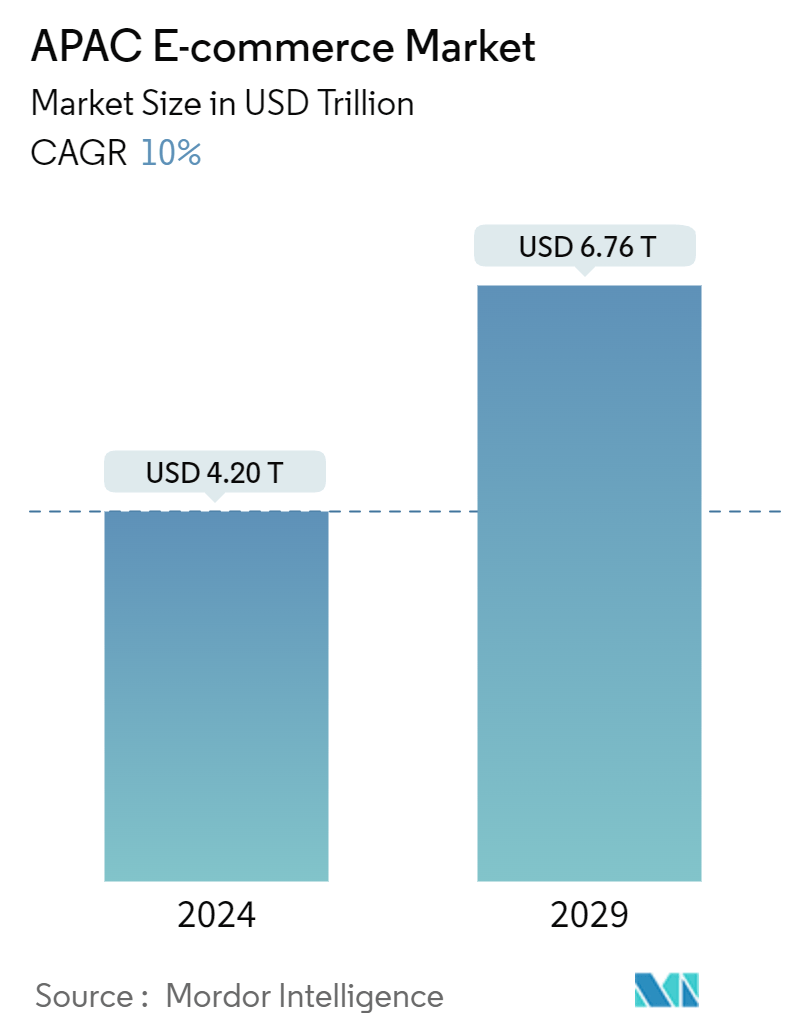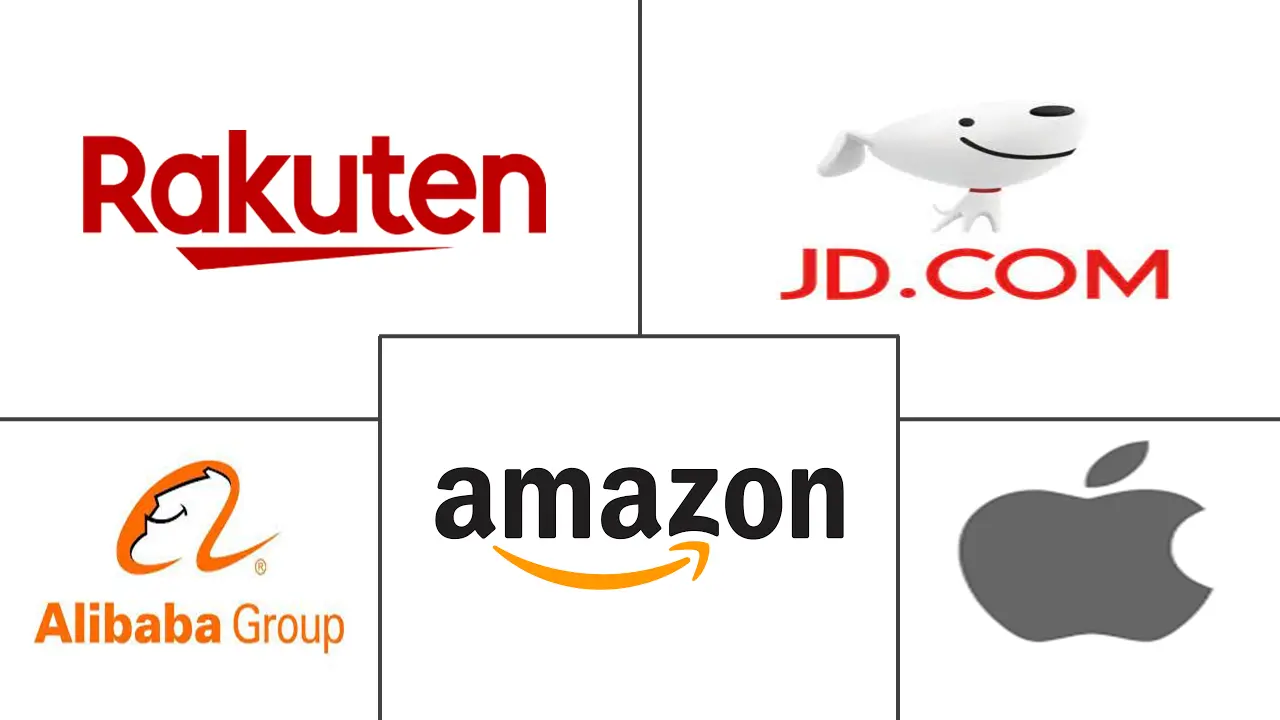Market Size of APAC E-commerce Industry

| Study Period | 2019 - 2029 |
| Base Year For Estimation | 2023 |
| Market Size (2024) | USD 4.20 Trillion |
| Market Size (2029) | USD 6.76 Trillion |
| CAGR (2024 - 2029) | 10.00 % |
| Market Concentration | Low |
Major Players
*Disclaimer: Major Players sorted in no particular order |
APAC E-commerce Market Analysis
The APAC E-commerce Market size is estimated at USD 4.20 trillion in 2024, and is expected to reach USD 6.76 trillion by 2029, growing at a CAGR of 10% during the forecast period (2024-2029).
Consumers around the region have started to focus on online shopping due to expanding internet access and the quick, efficient, and effective distribution of goods.
- Asia has experienced a rapid increase in internet accessibility and penetration, which has sparked the region's subsequent digitization. Other industries transformed to keep up with the new, technology-driven economy worldwide, along with the area and its residents. The retail sector is one such enterprise.
- Ready-to-eat food delivery has become a significant market due to enticing, user-friendly apps, tech-enabled driver networks, and shifting consumer expectations. Food delivery services now provide a convenient and efficient way to buy food whenever and wherever customers want. The invention of online food delivery services came about due to new technological advancements and the COVID-19 outbreak, which compelled food service operators to develop innovative methods and platforms to minimize customer interaction when ordering and eating meals.
- One of the biggest trends in online retail is platform convergence. Customers prefer an all-in-one shopping experience that includes product ratings and prices, buying, and making payments using the platforms' new online payment options. Consequently, online shopping features are available on portal websites, social media, TV home shopping, over-the-top media services (OTT), etc. As a result, their platforms are becoming more popular.
- E-commerce enterprises generally store customers' bank accounts and credit card information. Email addresses, mailing addresses, usernames, and passwords are usually held by e-commerce enterprises, subjecting them to cybersecurity attacks. Cybercriminals profit from this information by duplicating credit cards and utilizing users' personal information for identity theft and fraud. Hackers may potentially hold sensitive data hostage for ransom.
APAC E-commerce Industry Segmentation
E-commerce refers to selling clothing, electronics, furniture, books, cosmetics, and other items over the Internet. Companies that provide home delivery services, such as e-commerce and m-commerce, are included in this industry.
The Asia-Pacific e-commerce market is segmented by application (beauty and personal care, consumer electronics, fashion and apparel, food and beverage, furniture, and home), by country (China, India, Japan, South Korea, and the rest of Asia-Pacific). The report offers market forecasts and size in value (USD) for all the above segments.
| By B2C ecommerce | ||||||||
| Market size (GMV) for the period of 2017-2027 | ||||||||
|
| By B2B ecommerce | |
| Market size for the period of 2017-2027 |
| Geography*** | |
| China | |
| India | |
| Japan | |
| South Korea |
APAC E-commerce Market Size Summary
The Asia-Pacific e-commerce market is experiencing significant growth, driven by increased internet accessibility and the rapid digitization of the region. This transformation has led to a surge in online shopping, with consumers favoring the convenience and efficiency of digital platforms. The retail sector, in particular, has adapted to these changes, with ready-to-eat food delivery services emerging as a prominent segment. The COVID-19 pandemic accelerated the adoption of online food delivery, prompting businesses to innovate and reduce customer interaction during the ordering process. Additionally, the trend of platform convergence is reshaping online retail, as consumers seek integrated shopping experiences across various digital channels, including social media and OTT services. However, the rise of e-commerce also brings challenges, such as cybersecurity threats, as businesses store sensitive customer information that can be targeted by cybercriminals.
The fashion industry in Asia-Pacific is poised for substantial growth, with the region becoming a key player in the global fashion market. The saturation of Western markets has led companies to focus on emerging markets like Asia, where local brands and street style are gaining prominence, particularly in countries like India. The influence of local celebrities and pop culture icons further drives consumer preferences, attracting investments from major players in fashion e-commerce. As consumer demands become more complex, driven by rising disposable incomes and a desire for personalized fashion, e-commerce sales in the fashion sector are expected to rise. The introduction of 5G technology is anticipated to boost mobile commerce, particularly in South Korea, enhancing the shopping experience with faster connectivity. Despite the challenges faced by traditional retail, e-commerce platforms are gaining traction, with companies like JD.com and Amazon implementing strategies to enhance customer experience and combat counterfeit goods. The competitive landscape is intensifying, with numerous players entering the market, further fueling the growth of e-commerce in the region.
APAC E-commerce Market Size - Table of Contents
-
1. MARKET INSIGHTS
-
1.1 Market Overview
-
1.2 Industry Attractiveness-Porter's Five Forces Analysis
-
1.2.1 Bargaining Power of Suppliers
-
1.2.2 Bargaining Power of Buyers/Consumers
-
1.2.3 Threat of New Entrants
-
1.2.4 Threat of Substitute Products
-
1.2.5 Intensity of Competitive Rivalry
-
-
1.3 Key market trends and share of e-commerce of total Retail sector
-
1.4 Impact of COVID-19 on the e-commerce sales
-
-
2. Market Segmentation
-
2.1 By B2C ecommerce
-
2.1.1 Market size (GMV) for the period of 2017-2027
-
2.1.2 Market Segmentation - by Application
-
2.1.2.1 Beauty & Personal Care
-
2.1.2.2 Consumer Electronics
-
2.1.2.3 Fashion & Apparel
-
2.1.2.4 Food & Beverage
-
2.1.2.5 Furniture & Home
-
2.1.2.6 Other Applications (Toys, DIY, Media, etc.)
-
-
-
2.2 By B2B ecommerce
-
2.2.1 Market size for the period of 2017-2027
-
-
2.3 Geography***
-
2.3.1 China
-
2.3.2 India
-
2.3.3 Japan
-
2.3.4 South Korea
-
-
APAC E-commerce Market Size FAQs
How big is the APAC E-commerce Market?
The APAC E-commerce Market size is expected to reach USD 4.20 trillion in 2024 and grow at a CAGR of 10% to reach USD 6.76 trillion by 2029.
What is the current APAC E-commerce Market size?
In 2024, the APAC E-commerce Market size is expected to reach USD 4.20 trillion.

